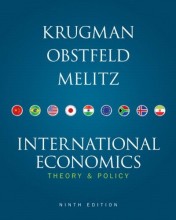Classical models of trade - The ricardian model: comparative advantage
8 important questions on Classical models of trade - The ricardian model: comparative advantage
When does a company have an absolute advantage?
When does a company have a competitive advantage?
A country has a CA if its opportunity costs are lower to produce a good
The CA differences in country and per kind of product enable trade
How is a country characterized by the Ricardian model?
- Higher grades + faster learning
- Never study anything twice
- 100% sure, 100% understanding
What is the possibilities production frontier?
The maximum combination given the use of all resources, the ppf shows the maximum combination of goods that can be produced.
The ppf is a resource constraint
Lc + Lw =< L
PPF = Lc + Lw = L
ac Qc + aw Qw = L
Total we can produce => Qc= L/ac
L= acQc + awQw (linear)
Qw= L/aw - ((ac/aw)*Qc)
slope= opportunity costs to produce (opprtunity costs are standard)
The HO model, the further you go down the line the higher the opportunity costs
What happens to the cpf/ppf curve after trade? in Home? in Foreign?
What does the slope of the cpf curve look like?
What does the slope of the ppf curve look like?
What is the empirical evidence for the Ricardian model?
Text book chapter 3
How to determine the changes in the CPF curve, after trade?
The question on the page originate from the summary of the following study material:
- A unique study and practice tool
- Never study anything twice again
- Get the grades you hope for
- 100% sure, 100% understanding





























